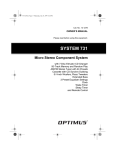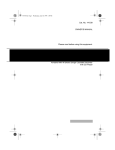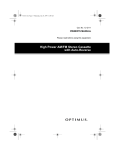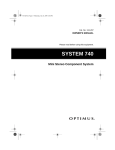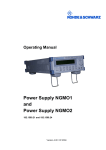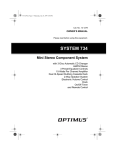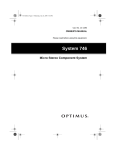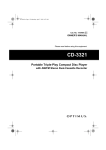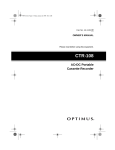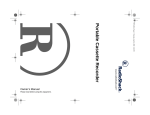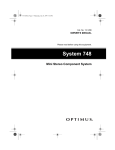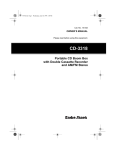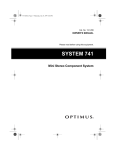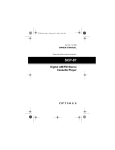Download Optimus SYSTEM 730 Home Theater System User Manual
Transcript
13-1277.fm Page 1 Wednesday, July 14, 1999 4:11 PM Cat. No. 13-1277 OWNER’S MANUAL Please read before using this equipment. SYSTEM 730 Mini Stereo Component System with 7-Disc Elevator CD Changer 50-Track Memory and Random Play AM/FM Stereo Tuner with 24 Presets Dual Cassettes with CD Synchro and Hi-Speed Dubbing 5-Inch Speakers Extended Bass 3 Preset Equalizer Settings Clock Wake Timer Sleep Timer and Remote Control R 13-1277.fm Page 2 Wednesday, July 14, 1999 4:11 PM FEATURES Your Optimus System 730 Mini Stereo Component System offers, in one attractive package, all of the features you need for excellent stereo sound and entertainment. The System 730 includes a 7-disc elevator CD changer, AM/FM stereo tuner, dual hi-speed cassette deck, speakers, and a remote control, as well as three preset graphic equalizer controls and several other special features. CD CHANGER FEATURES 7-Disc Elevator CD Changer — lets you load up to seven CDs and automatically play them one after another. Automatic Search Music System (ASMS) — lets you quickly locate and play any track on a CD. Audible Search — helps you locate a particular section of a CD by rapidly playing it in either direction. Programmable Play — lets you program and play up to 50 tracks in any order. Random Play — lets you set the System 730 to automatically play the tracks on all CDs in random order. CASSETTE DECK FEATURES Consecutive Play — lets you automatically play two cassette tapes, one after the other. Multiple Source Recording — lets you record onto a cassette tape from the CD changer, radio, another cassette tape, or from an external microphone (not supplied). CD Synchro Dubbing — simplifies recording from the CD player to a cassette tape. Automatic Level Control (ALC) — automatically adjusts the recording level. Hi-Speed Dubbing — lets you set the System 730 to record cassette tapes at one and a half times the normal speed. Auto-Stop — automatically stops the cassette tape when it finishes playing, recording, rewinding, or fastforwarding to protect the tape and tape-handling parts. Soft Cassette Tape Eject — slowly opens the cassette compartment door when you press the eject button, so the tape does not pop out. Repeat Play — lets you automatically repeat the tracks on all CDs or a series of programmed tracks. © 1995 Tandy Corporation. All Rights Reserved. Radio Shack and Optimus are registered trademarks used by Tandy Corporation. 2 13-1277.fm Page 3 Wednesday, July 14, 1999 4:11 PM OTHER SPECIAL FEATURES Remote Control — lets you control most of the System 730’s functions from a distance. Dual Backlit LCD Displays — clearly displays your system’s indicators for easy viewing in almost any lighting condition. Three Preset Graphic Equalizer Settings — provide common sound settings for enhancing rock, pop, or classical music at the press of a button. Digital Clock — gives you a digital time display even when the System 730 is turned off. Memory Tuning — lets you store and easily recall up to 24 of your favorite AM and FM radio stations. Wake Timer — lets you set the System 730 to automatically turn itself on and play the last selected radio station, CD, or cassette tape. Note: The remote control requires two AAA batteries (not supplied) for power. Read this manual carefully. It will help you get the most enjoyment from your System 730. For your records, we urge you to record the serial number of your System 730 in the space below. The serial number is located on the back of the system. Serial Number Warning: To prevent fire or shock hazard, do not expose this product to rain or moisture. CAUTION RISK OF ELECTRIC SHOCK. DO NOT OPEN. CAUTION: TO REDUCE THE RISK OF ELECTRIC SHOCK, DO NOT REMOVE COVER OR BACK. NO USER-SERVICEABLE PARTS INSIDE. REFER SERVICING TO QUALIFIED PERSONNEL. This symbol is intended to alert you to the presence of uninsulated dangerous voltage within the product’s enclosure that might be of sufficient magnitude to constitute a risk of electric shock. Do not open the product’s case. Sleep Timer — lets you set your system to automatically turn itself off after up to 90 minutes. Auxiliary Input Jacks — let you connect an additional audio source, such as a TV, VCR, turntable, or an external CD changer or cassette deck, to your system. ! ! This symbol is intended to inform you that important operating and maintenance instructions are included in the literature accompanying this product. 3 13-1277.fm Page 4 Wednesday, July 14, 1999 4:11 PM Most CDs that can be played on this changer have this mark on them: Warning: This CD changer employs a laser light beam. Only a qualified service person should remove the cover or attempt to service this device, due to possible eye injury. 4 Note: Most material on compact discs and prerecorded tapes is copyrighted. Unauthorized duplication of copyrighted material is a violation of the copyright laws of most countries and such duplication may result in fines and/or imprisonment. Note, however, that in the United States, it is not a violation of U.S. copyright laws for a consumer to use an audio recording device to duplicate musical recordings for noncommercial (personal) use. 13-1277.fm Page 5 Wednesday, July 14, 1999 4:11 PM TABLE OF CONTENTS Preparation ..................................................................................................... 7 Connecting the Speakers .......................................................................... 7 Speaker Placement ............................................................................. 7 Connecting the FM Antenna ...................................................................... 8 Connecting an Additional Audio Source .................................................... 8 Connecting Power ..................................................................................... 8 Setting the Current Time ............................................................................ 9 Installing Batteries in the Remote Control ................................................. 9 Connecting Headphones ......................................................................... 10 Listening Safely ................................................................................. 10 Basic Operation ............................................................................................ Using the Demonstration Feature ............................................................ Using the Remote Control ....................................................................... Turning On/Off the System ...................................................................... Setting the Sound .................................................................................... Adjusting the Volume ......................................................................... Adjusting the Balance ........................................................................ Using Extended Bass (X-BASS) ....................................................... Changing the Preset Graphic Equalizer Settings .............................. 11 11 11 11 12 12 12 12 13 Radio Operation ........................................................................................... Listening to the Radio .............................................................................. Using Memory Tuning .............................................................................. Storing a Station in Memory .............................................................. Recalling a Stored Station ................................................................. 14 14 15 15 16 CD Changer Operation ................................................................................. Loading and Playing a CD ....................................................................... Special CD Changer Features ................................................................. Automatic Search Music System (ASMS) ......................................... Audible Search .................................................................................. Random Play ..................................................................................... Repeat Play ....................................................................................... Cue .................................................................................................... Programmed Play .................................................................................... Storing/Playing a Programmed Sequence ........................................ Reviewing a Programmed Sequence ................................................ Erasing a Programmed Sequence .................................................... CD and CD Changer Care Tips ............................................................... 17 17 19 19 19 19 20 20 21 21 22 23 23 5 13-1277.fm Page 6 Wednesday, July 14, 1999 4:11 PM Cassette Deck Operation ............................................................................ Loading a Tape ........................................................................................ Playing a Tape ......................................................................................... Consecutive Play .............................................................................. Recording onto a Cassette Tape ............................................................. Recording from a CD ........................................................................ Copying Cassette Tapes ................................................................... Recording from the Radio ................................................................. Recording from an External Microphone .......................................... Tape Tips ................................................................................................. Erasing a Cassette Tape ................................................................... Preventing Accidental Erasure .......................................................... Restoring Tape Tension and Sound Quality ...................................... 25 25 26 26 27 27 29 30 31 32 32 32 32 Using an Additional Audio Source ............................................................. 33 Listening to an Additional Audio Source .................................................. 33 Recording from an Additional Audio Source ............................................ 33 Special Features .......................................................................................... Setting a Wake Up Time .......................................................................... Setting the Sleep Timer ........................................................................... Using an External Microphone ................................................................ 34 34 35 36 Maintenance ................................................................................................. 37 The FCC Wants You to Know .................................................................. 38 Cleaning the Tape-Handling Parts............................................................. 38 Specifications ............................................................................................... 39 6 13-1277.fm Page 7 Wednesday, July 14, 1999 4:11 PM PREPARATION Important: Complete all other connections to the System 730 before you connect it to power. CONNECTING THE SPEAKERS 1. Press open the pair of terminal tabs marked MAIN SPEAKERS/ + R – on the back of the System 730, then insert the right speaker’s red wire into the red (+) terminal and its black wire into the black (–) terminal. Then release the tabs. Note: You can use the set of terminals marked SURROUND SPEAKER to connect surround sound speakers (not supplied) to your System 730. Your local Radio Shack sells a wide selection of surround sound speakers. Speaker Placement For the best stereo effect, place the speakers so the distance between them is the same as the distance between the listening area and the point halfway between the speakers. You might want to experiment with several locations to find the best one. Notes: • If the you place the speakers far apart, you can improve the stereo effect by angling the speakers toward you. Caution: To avoid damaging your system and speakers, never let the speaker wire’s bare ends touch each other. 2. Repeat Step 1 to connect the left speaker’s wires to the terminals marked MAIN SPEAKERS/ + L –. • To increase the bass sound, place the speakers in the corner of the room, against the wall or directly on the floor. • To decrease the bass sound, move the speakers slightly away from the corner, increase the distance between them, and/or raise them 6 to 8 inches off the floor. You can purchase speaker stands at your local Radio Shack store. 7 13-1277.fm Page 8 Wednesday, July 14, 1999 4:11 PM CONNECTING THE FM ANTENNA To connect the supplied FM antenna, loosen the screw caps on the terminals marked FM ANTENNA/300Ω on the back of the System 730, slip the antenna’s spade lugs onto the terminals, then tighten the screw caps. Notes: • See “Using an Additional Audio Source” to operate an external audio source with the System 730. • If you connect a turntable to the System 730, the turntable must have a built-in equalizer amplifier. CONNECTING POWER Note: You can use the set of screw caps on the terminals marked FM ANTENNA/75Ω to connect a 75Ω FM antenna (not supplied) to your System 730. To connect power after making all other connections, plug your system’s AC cord into a standard AC outlet. STAND-BY/MUTE turns on and 12:00 flashes on the display. CONNECTING AN ADDITIONAL AUDIO SOURCE To connect an additional audio source to your System 730, such as a TV, VCR, CD changer or cassette deck, plug the audio source’s left and right line level audio wires into INPUT VIDEO L (left) and R (right). 8 Caution: Your system’s AC power cord has a polarized plug (one blade is wider than the other). If you have difficulty inserting the plug into the outlet, do not force it. Turn the plug over and try again. 13-1277.fm Page 9 Wednesday, July 14, 1999 4:11 PM SETTING THE CURRENT TIME 1. Press POWER to turn on the System 730, then press DISPLAY once. TIME and the lastset time appear on the display. • If TIME disappears before you finish setting the hour and minute, start again from Step 1. • When power is disconnected or interrupted, then restored, the last known time flashes on the display. If this happens, reset the time. INSTALLING BATTERIES IN THE REMOTE CONTROL 2. Within 5 seconds, press HOUR to change the hour setting or MINUTE to change the minute setting. The remote control requires two AAA batteries (not supplied) for power. For the best performance and longest life, we recommend alkaline batteries, such as Radio Shack Cat. No. 23-555. Caution: Always use fresh batteries of the required size and type. 1. To open the battery compartment cover, slide it in the direction of the arrow. Notes: • When changing the hour, be sure to set it the correct AM or PM hour. • To rapidly advance the hour or minute setting, press and hold HOUR or MINUTE . 9 13-1277.fm Page 10 Wednesday, July 14, 1999 4:11 PM 2. Insert the batteries into the compartment as indicated by the polarity symbols (+ and –) marked inside. To connect headphones, plug the headphone’s 1/8-inch plug into the PHONES jack on the front of the System 730. 3. Replace the cover. Note: Connecting headphones automatically disconnects the System 730’s speakers. Notes: • If you will not be using the remote control for a month or more, remove the batteries. • You can use the remote control up to a distance of about 20 feet (6.1 meters) in front of the System 730. If it does not operate properly within this distance, replace the batteries. Warning: Always dispose of old batteries promptly and properly. CONNECTING HEADPHONES To listen without disturbing others, you can connect a pair of stereo headphones with a 1/8-inch plug (not supplied) to the System 730. Your local Radio Shack store sells a wide selection of stereo headphones. 10 Listening Safely To protect your hearing, follow these guidelines when you use headphones. • Set the volume to the lowest setting before you begin listening. After you begin listening, adjust the volume to a comfortable level. • Do not listen at extremely high volume levels. Extended highvolume listening can lead to permanent hearing loss. • Once you set the volume, do not increase it. Over time, your ears adapt to the volume level, so a volume level that does not cause discomfort might still damage your hearing. 13-1277.fm Page 11 Wednesday, July 14, 1999 4:11 PM BASIC OPERATION USING THE DEMONSTRATION FEATURE To showcase the features of your System 730 and its dual display, press DEMO, or press and hold DISPLAY for about 2 seconds. The system repeatedly runs a preset program on both displays. Press DEMO or DISPLAY to stop the demonstration. USING THE REMOTE CONTROL Note: The buttons on the remote control and the system’s front panel operate several of the same functions, although they might be labeled differently. You can use either of these controls to operate the System 730. Caution: Exposing the remote control or SENSOR to direct sunlight or strong lights, such as a spotlight, will reduce the remote control’s operating distance and can make it inoperative. TURNING ON/OFF THE SYSTEM Press POWER to turn on the System 730. STAND-BY/MUTE turns off and the system’s last selected settings appear on the displays. The remote control communicates with your system through the remote sensor located on the front of the system. To use the remote control, be sure that the front end of it is pointing with a clear path toward SENSOR, then press the desired button(s). To turn off the system, press POWER again. STAND-BY/MUTE turns on. 11 13-1277.fm Page 12 Wednesday, July 14, 1999 4:11 PM SETTING THE SOUND Adjusting the Volume To increase the system’s volume, turn VOLUME toward MAX, or press VOLUME + on the remote control. To decrease the volume, turn VOLUME toward MIN, or press VOLUME – on the remote control. Adjusting the Balance To change the sound balance between the left and right speakers, rotate BALANCE toward L (left) or R (right). Using Extended Bass (X-Bass) Important: To prevent hearing damage, set the volume to its minimum level before playing the radio, a CD, or a cassette tape. Note: To turn off the sound temporarily, press MUTE on the remote control. STAND-BY/MUTE flashes. To resume listening, press MUTE again. STAND-BY/MUTE turns off. 12 To enhance the System 730’s bass sound, press X-BASS (Extended Bass). X-BASS appears on the left display. To return to normal bass sound, press it again. X-BASS disappears from the display. 13-1277.fm Page 13 Wednesday, July 14, 1999 4:11 PM Changing the Preset Graphic Equalizer Settings The sound produced by your System 730 is delivered over five different sound frequencies — 70 Hz, 300 Hz, 1 KHz, 3.5 KHz, and 10 KHz. You can set the balance of these frequencies using your system’s three preset graphic equalizer settings. These settings are designed to give you the best sound for rock, pop, and classical music. At all times during radio, CD, and cassette play and/or recording, light bars rise and fall on the system’s left display to show the current sound level for each of the five frequencies. In addition, a light bar marked LEVEL shows the average level of all combined frequencies. Each time you turn it on, the System 730 automatically uses the last selected graphic equalizer setting. To change the setting, press ROCK, POP, or CLASSIC . ROCK, POP, or CLASSIC appears on the display. 13 13-1277.fm Page 14 Wednesday, July 14, 1999 4:11 PM RADIO OPERATION LISTENING TO THE RADIO 1. Repeatedly press TUNER to select the desired band. Select AM for AM stations, or FM1 or FM2 for FM stations. As you press TUNER, AM, FM1 or FM2 and the last selected station appear on the display. Note: You can tune to any FM station when either FM1 or FM2 is selected, and you can also store and recall stations in memory in the two FM groups (see “Using Memory Tuning”). 2. Press TUNING UP or DOWN, or TUNING s or t on the remote control, to tune to the desired station. As you press the button, the frequency number changes on the display. 14 To rapidly scan for a station, press AUTO/MANUAL, or O/ AUTO on the remote control, so AUTO appears on the display. Then press and hold TUNING UP or DOWN, or TUNING s or t on the remote control, for about 1 second. When you release it, the tuner automatically stops at the next strong station. To resume manual tuning, press AUTO/MANUAL, or O/AUTO on the remote control, so AUTO disappears. Notes: • Each time you press TUNER or TUNING s or t, the System 730 automatically sets STEREO/MODE to STEREO. If the broadcast is being received in stereo, STEREO appears on the display. 13-1277.fm Page 15 Wednesday, July 14, 1999 4:11 PM • To improve reception for weak FM stereo stations, press MONO STEREO/MODE so (monaural) appears on the display. The sound is no longer in stereo, but reception should improve. To return to stereo sound, press STEREO/ MODE. • For the best FM reception, fully extend the FM antenna. • The AM antenna is built-in. To improve AM reception, move or re-position the System 730. 3. Set VOLUME (or press VOLUME + or – on the remote control) to the desired level, and select the desired X-BASS and graphic equalizer settings. MEMORY MEMORY. 3. Press appears on the display. 4. Within 3 seconds, press a number (1-8) for the memory location where you want to store the station. MEMORY disappears, and P (program), the selected memory number, and STATION appear on the display. For example, if you select memory STATION number 8, P8 appears. USING MEMORY TUNING You can store and easily recall up to 24 of your favorite AM and FM radio stations (8 AM and 16 FM) in the System 730’s memory. Storing a Station in Memory 1. Press TUNER to select AM, FM1, or FM2. 2. Press TUNING UP or DOWN, or TUNING s or t on the remote control, to tune to the desired station. Note: If MEMORY disappears before you press the desired memory number, repeat Steps 3 and 4 then try again. 5. Repeat Steps 2-4 to store up to eight stations each in AM, FM1, and FM2. Notes: • You cannot clear a station from memory, but you can store a new one in its place. 15 13-1277.fm Page 16 Wednesday, July 14, 1999 4:11 PM • When power is disconnected or interrupted for 50 hours or more, the System 730 loses all of its memory settings. Recalling a Stored Station 1. Press TUNER desired band. to select the 2. Press the desired station’s memory number (1-8). P, the memory number, STATION, and the frequency number appear on the display. 16 13-1277.fm Page 17 Wednesday, July 14, 1999 4:11 PM CD CHANGER OPERATION The System 730 lets you load up to seven CDs at once and gives you many options to control the way it plays them. 3. Press OPEN/LOAD. The changer drawer opens. CD Note: You can play a 3-inch CD in your System 730, but you must load it in CD tray position 1 (see “Loading and Playing a CD”). LOADING AND PLAYING A CD 4. Carefully place a CD in the drawer with the label facing up. 1. Press CD. CD, the last selected 1 CD number, and TRACK appear on the display. 2. To select a CD tray position (17), press the corresponding disc number, or press DISC then the desired disc number on the remote control. CD, the selected position number, and TRACK 1 appear on the display. 5. To load more CDs (up to seven), simply press the next DISC NUMBER. The CD drawer closes, the changer moves to the selected position, then the drawer automatically opens again so you can load the next CD. After you have loaded all the CDs, press OPEN/LOAD again. The drawer automatically closes. Note: A box ( ) appears around the disc number on the display when the position is full. 17 13-1277.fm Page 18 Wednesday, July 14, 1999 4:11 PM 6. To play the last CD you loaded, press PLAY , or CD on the remote control. t t To play a different CD, press the desired disc number, or press DISC then the disc number on the remote control, to select the CD. Then press PLAY , or press CD on the remote control to begin play. appears, then the selected CD begins to play, and its elapsed play time appears. 7. Set VOLUME (or press VOLUME + or – on the remote control) to the desired level, and select the desired X-BASS and graphic equalizer settings. 8. The System 730 automatically stops play at the end of the highest numbered CD loaded in the system. For example, if you have four CDs loaded, play stops automatically at the end of the fourth CD. To stop the CD changer at any time during play, press STOP , or press CD on the remote control. and the CD’s elapsed play time disappear from the display. Notes: • To skip over, search, or repeat tracks, see “Special CD Changer Features.” • To briefly stop play, press PAUSE on the main system. appears on the display. t t To resume play, press PLAY , or CD on the remote control. disappears. 18 Note: To display the total playing time of a selected CD, press TIME on the remote control before or during play. The total playing time appears on the display for about 5 seconds. 13-1277.fm Page 19 Wednesday, July 14, 1999 4:11 PM SPECIAL CD CHANGER FEATURES control. The CD rapidly advances and you hear the music at a high speed and low volume. Automatic Search Music System (ASMS) Release the button to resume normal play. The automatic search music system lets you skip forward or backward through the tracks on all loaded CDs. Random Play • To skip to the beginning of the next track, press and release >> , or CD >> on the remote control. The System 730 lets you set the CD changer to play the tracks on all CDs in random order. 1. With at least one CD in the CD changer and no CD playing, press RANDOM on the main system. RANDOM., , and the first randomly selected disc and track number appear on the display. Then the track begins to play, and its elapsed play time appears. • To return to the beginning of the current track, press and release <<, or CD << on the remote control. • To skip backward or forward through additional tracks, repeatedly press and release << or >> , or CD << or >> on the remote control, until the desired track number appears on the display. Audible Search To search backward or forward during play, press and hold down << or >> , or CD << or >> on the remote Notes: • To skip to the next randomly selected track, press RANDOM again. • You can search forward or backward on the current disc or repeat all tracks during random play. 19 13-1277.fm Page 20 Wednesday, July 14, 1999 4:11 PM 2. To briefly stop random play, press PAUSE on the main system. appears on the display. To resume play, press PLAY , or CD on the remote control. disappears. 3. The System 730 automatically stops random play after it has played all tracks on all loaded CDs. To stop the CD changer at any time during random play, press STOP , or CD on the remote control. RANDOM, , and the CD’s elapsed play time disappear from the display. To continuously repeat an entire programmed sequence, first program the tracks you want to play (see “Programmed Play”), then press REPEAT before or during play so REPEAT appears on the display along with MEMORY. To cancel repeat play before, during, or after play, press REPEAT so REPEAT disappears from the display. If repeat is cancelled during play, the CD changer resumes normal play. Cue Repeat Play The System 730 lets you continuously repeat all tracks on all loaded CDs or an entire programmed sequence. To continuously repeat the tracks on all loaded CDs, press REPEAT before or during play so REPEAT appears on the display. 20 To select a track before you begin play or after pressing PAUSE on the main system, press << or >> or CD << or >> on the remote control, until the desired track number appears on the display. Then press PLAY , or CD on the remote control, to play the track. 13-1277.fm Page 21 Wednesday, July 14, 1999 4:11 PM PROGRAMMED PLAY You can program the CD changer to play up to 50 tracks in any order you choose, and you can program the same CD and/or track to play more than once. Storing/Playing a Programmed Sequence 1. With at least one CD in the CD changer and no CD playing, select a CD by pressing the corresponding disc number (1-7), or press DISC then the desired number on the remote control. CD, the selected CD number, and TRACK 1 appear on the display. 2. Track 1 of the current CD is automatically selected. To select a different track, press << or >> on the main system, or CD << or >> or the desired track number on the remote control. As you press it, the track number changes on the display. 3. To store the selected track, press MEMORY on the remote control. MEMORY flashes for about 4 seconds, then lights steadily, and P-01 (the program position number) appears for about 10 seconds. Note: If you pressed the desired track number on the remote control, the track number flashes on the display and you must press MEMORY within 4 seconds. If the track number stops flashing before you press MEMORY, repeat Step 2 then try again. 4. Repeat Steps 1-4 to store up to 50 tracks. Note: If you try to store more than 50 tracks, FULL appears on the display. 21 13-1277.fm Page 22 Wednesday, July 14, 1999 4:11 PM 5. Press PLAY , or CD on the remote control, to play the programmed sequence. , P-01, and the first programmed CD and track number appear. Then the CD’s elapsed play time appears, and the first track begins to play. Note: To briefly stop programmed play, press PAUSE on the main system. appears on the display. To resume programmed play, press PLAY , or CD on the remote control. disappears. 6. Programmed play automatically stops at the end of the last programmed track. To stop the CD changer at any time during programmed play, press and release STOP , or press CD on the remote control. and the CD’s elapsed play time disappear from the display. 22 Notes: , or CD on the • Press PLAY remote control, to play the programmed sequence again. • To replace a programmed track, press RECALL on the remote control until the memory number of the track you want to replace appears on the display. Then repeat Steps 1-3 to store a new track. • To resume regular or random play after storing a programmed sequence, you must first erase the programmed sequence (see “Erasing a Programmed Sequence”). Reviewing a Programmed Sequence To review a programmed sequence, while play is stopped, repeatedly press RECALL on the remote control. As you press it, the CD, track number, and memory position of each stored track appears. 13-1277.fm Page 23 Wednesday, July 14, 1999 4:11 PM Erasing a Programmed Sequence CD AND CD CHANGER CARE TIPS To erase an entire programmed sequence, while play is stopped, press and hold STOP , or CD on the remote control, for at least 2 seconds. MEMORY disappears from the display. Although a CD is very durable, you should handle it with care. We recommend the following precautions. • Keep the CD in its protective case or sleeve when you are not playing it. • Keep the CD clean. Your local Radio Shack store sells a suitable CD cleaner kit. Notes: • If you remove a CD, the CD changer automatically skips that disc’s tracks in the sequence. • When power is disconnected or interrupted for 50 hours or more, any programmed sequence is entirely erased. • Keep the CD dry. A drop of moisture can act as a lens and affect the laser beam’s focus. If it gets wet, wipe the CD with a soft, dry cloth before playing it. • Do not write on either side of a CD, especially the non-label side. • Handle the CD by its edges to avoid fingerprints and surface scratches, which can prevent the laser from accurately reading the CD. If the CD gets scratched, use Scratch ‘n’ Fix (Radio Shack Cat. No. 42-127) to keep the CD from skipping during play. • Do not store CDs in high-temperature, high-humidity locations. 23 13-1277.fm Page 24 Wednesday, July 14, 1999 4:11 PM If the System 730 is subjected to a sudden shock or jolt during play, the CD’s rotation speed might suddenly change, and the music might be briefly interrupted. This is not a malfunction. Cautions: • To avoid damaging the CD changer, do not place anything but a CD in the CD drawer. • Remove any loaded CDs from the CD changer before moving the System 730 to prevent damaging the CDs. • Moving the CD changer suddenly from a cold place to a warmer one can cause moisture to form on the pickup lens and disrupt operation. If this happens, wait about 2 hours before playing a CD. 24 13-1277.fm Page 25 Wednesday, July 14, 1999 4:11 PM CASSETTE DECK OPERATION The System 730 has a dual cassette deck system which lets you automatically play two cassette tapes consecutively, record from the CD changer, record one cassette tape onto another, and more. Notes: • The remote control does not operate the System 730’s cassette deck. • Before recording, be sure the cassette tape’s erase-protection tabs are in place. See “Preventing Accidental Erasure.” LOADING A TAPE 1. Press STOP/EJECT on the desired tape deck (TAPE 1 or TAPE 2) to open the cassette compartment door. • The System 730’s Automatic Level Control (ALC) feature automatically adjusts the recording level. The settings of VOLUME, X-BASS, and ROCK, POP, or CLASSIC have no effect on the recording. • Tape quality greatly affects the quality of the recording. We recommend regular length (60- or 90-minute) cassette tapes. We do not recommend long-play cassette tapes, such as C-120s, because they are thin and can easily tangle in the cassette mechanism. For low-noise, wide-range recordings, use normal-bias tape. Note: TAPE 1 only plays prerecorded cassette tapes. TAPE 2 both plays back and records. 2. Insert the cassette tape into the tape guides with the exposed tape edge facing down, the side you want to play facing you, and the full reel to the left. • Before you load a cassette tape for recording, turn the cassette’s hub with your finger or a pencil to take up any slack and move the tape past its leader. (Avoid touching the tape with your fingers.) 3. Close the door. 25 13-1277.fm Page 26 Wednesday, July 14, 1999 4:11 PM PLAYING A TAPE 1. Press TAPE . TAPE appears on the display. 2. Press PLAY. The tape begins to play. 4. The System 730 automatically stops the tape when it reaches the end. To stop the tape at any time during playback, press STOP/EJECT. Consecutive Play You can set the System 730 to automatically play the first side of the cassette tape in each deck, one after the other. Note: To briefly stop the tape during playback, press PAUSE. The button locks and the tape stops. Press PAUSE again to continue playback. 3. Set VOLUME (or press VOLUME + or – on the remote control) to the desired listening level, and select the desired X-BASS and graphic equalizer settings. 26 1. Load the first cassette tape you want to play into TAPE 1, and the other into TAPE 2. Be sure the side of each tape you want to play is facing out. 2. Press PLAY on TAPE 1. The tape in TAPE 1 begins to play. 3. Press PAUSE , then PLAY on TAPE 2. Both buttons lock. 13-1277.fm Page 27 Wednesday, July 14, 1999 4:11 PM When the tape in TAPE 1 reaches the end, the tape in TAPE 2 automatically begins to play. Note: To briefly stop the tape in either deck during playback, press PAUSE on the desired deck. The button locks and the tape stops. Press PAUSE again to continue playback. 4. At the end of the tape in TAPE 2, the system automatically stops the tape. To stop playback on either deck at any time, press STOP/EJECT on that deck. PLAY releases. Notes: • If you press STOP/EJECT on TAPE 1 during consecutive play, the tape in TAPE 2 automatically begins to play. • To rapidly fast-forward or rewind a cassette tape in either deck while the tape is stopped, press FAST-F or REWIND. The button locks and the tape fast-forwards or rewinds. The System 730 automatically stops the tape when it reaches the end. To stop the tape at any time during fast-forwarding or rewinding, press STOP/EJECT. RECORDING ONTO A CASSETTE TAPE The System 730 lets you record onto a cassette tape from the CD changer, radio, another cassette tape, or from an external microphone (not supplied). Note: You can also record from an additional audio source (see “Recording from an Additional Audio Source”). Caution: Never try to force down RECORD after you remove an eraseprotection tab from a cassette tape (see “Preventing Accidental Erasure”). You might damage the tape mechanism. Recording from a CD Follow these steps to record from a CD onto a cassette tape. 1. Press CD. CD, the last selected 1 CD number, and TRACK appear on the display. 2. Load the CD(s) you want to record into the CD changer. 27 13-1277.fm Page 28 Wednesday, July 14, 1999 4:11 PM 3. Load a blank cassette tape, or one you want to record over, into TAPE 2. 4. To record the tracks from all loaded CDs in order, press the disc number of the first CD you want to begin recording, or press DISC then the number on the remote control. To record only selected tracks or change the sequence of the tracks, you must first program the desired sequence. 5. To automatically start the CD and begin recording at the same time (synchronously), press RECORD on TAPE 2. PLAY automatically locks down with RECORD , and appears. Then the first selected CD or programmed track begins to play, its elapsed play time appears, and the tape begins recording. Note: To briefly stop the tape while recording, press PAUSE on TAPE 2. The button locks and the tape stops. Press PAUSE again to resume recording. 28 To briefly stop the CD while recording, press PAUSE on the main system. appears on the display. To resume play, press PLAY , or press CD on the remote control. disappears. 6. To listen to the CD during recording, adjust VOLUME (or press VOLUME + or – on the remote control) to the desired listening level, and select the desired X-BASS and graphic equalizer settings. 7. The System 730 automatically stops the tape when it reaches the end. To stop the tape at any time during recording, press STOP/EJECT on TAPE 2. To stop the CD during or after on the recording, press STOP CD changer, or press CD on the remote control. Note: The System 730 automatically stops the CD changer when it reaches the end of all loaded CDs or the programmed sequence. If the tape is still recording, press STOP/EJECT on TAPE 2 to stop the tape. 13-1277.fm Page 29 Wednesday, July 14, 1999 4:11 PM Copying Cassette Tapes The System 730 lets you dub (copy) one cassette tape to another, one side at a time, using its dual cassette decks (TAPE 1 and TAPE 2). 1. Load a blank cassette tape, or one you want to record over, into TAPE 2. 2. Load the tape you want to record from into TAPE 1. 3. Press PAUSE , then RECORD on TAPE 2. PLAY automatically locks down with RECORD and PAUSE. 5. Press PLAY on TAPE 1. The tape in TAPE 1 begins to play, PAUSE automatically releases on TAPE 2, and TAPE 2 begins to record. 6. To listen to the tape in TAPE 1 during recording, adjust VOLUME (or press VOLUME + or – on the remote control) to the desired listening level, and select the desired X-BASS and graphic equalizer settings. Note: If you use HI-SPEED during recording, you hear the sound at one and a half times the normal speed. 7. To briefly stop the tape in either deck while recording, press PAUSE on that deck. The button locks and the tape stops. Press PAUSE again to resume recording. 4. To record at one and a half times the normal speed, press HISPEED. HI-SPEED appears on the display. To set it back to normal speed, press HI-SPEED again. HI-SPEED disappears. 8. The System 730 automatically stops the tape in each deck when the tape reaches the end of the side. To stop the tape in either deck at any time during recording, press STOP/EJECT on that deck. 29 13-1277.fm Page 30 Wednesday, July 14, 1999 4:11 PM Notes: • If you press STOP/EJECT on TAPE 1, PLAY releases on that deck, but recording on TAPE 2 continues. • If you press STOP/EJECT on TAPE 2, PLAY and RECORD release, and recording stops. Recording from the Radio The System 730 lets you record onto a cassette tape from any AM or FM radio station. You can also set it to automatically turn on at a preset time and begin recording from the radio. 1. Repeatedly press TUNER to select the desired band, then select the desired station. 2. Load a blank cassette tape, or one you want to record over, into TAPE 2. 3. Press PAUSE then RECORD on TAPE 2. PLAY automatically locks down with RECORD and PAUSE . Note: To briefly stop the tape while recording, press PAUSE on TAPE 2. The button locks and the tape stops. Press PAUSE again to resume recording. 5. To listen to the radio during recording, adjust VOLUME (or press VOLUME + or – on the remote control) to the desired listening level, and select the desired X-BASS and graphic equalizer settings. 6. The System 730 automatically stops the tape when it reaches the end. To stop the tape at any time during recording, press STOP/EJECT on TAPE 2. RECORD and PLAY release, and recording stops. To set your System 730 to automatically begin recording from the radio at a preset time, first set and turn on the wake-up timer (see “Setting a Wake Time”). Then follow Steps 1-3 above, press POWER to turn off the system, then release PAUSE on TAPE 2. At the 4. Release PAUSE on TAPE 2 to begin recording. 30 preset wake up time, your system automatically turns itself on and imme- 13-1277.fm Page 31 Wednesday, July 14, 1999 4:11 PM diately begins recording from the radio. 31 13-1277.fm Page 32 Wednesday, July 14, 1999 4:11 PM Recording from an External Microphone The System 730 lets you record onto a cassette tape using an external microphone with a 1/8-inch plug (not supplied), such as Radio Shack Cat. No. 33-2001. Note: The system also lets you hear sound from an external microphone combined with sound from the radio, a prerecorded CD or cassette, or an additional audio source (see “Using an External Microphone”). 1. Plug the microphone’s 1/8-inch plug into MIC on the front of the System 730. 5. Press PAUSE on TAPE 2 to begin recording. Any sound captured by the external microphone is recorded on the tape. Notes: • Follow any instructions provided with the external microphone for placement of the microphone to achieve the best recording results. • To briefly stop the tape while recording, press PAUSE on TAPE 2. The button locks and the tape stops. Press PAUSE again to resume recording. 2. Press TAPE . TAPE appears on the display. 6. To increase the volume of the microphone’s sound input, turn MIXING MAX. toward To decrease it, turn it toward MIN. 3. Load a blank cassette tape, or one you want to record over, into TAPE 2. 4. Press PAUSE then RECORD on TAPE 2. PLAY automatically locks down with RECORD and PAUSE . 32 7. To hear the sound being recorded, adjust VOLUME , or press VOLUME + or – on the 13-1277.fm Page 33 Wednesday, July 14, 1999 4:11 PM remote control, to the desired level. 33 13-1277.fm Page 34 Wednesday, July 14, 1999 4:11 PM 8. The System 730 automatically stops the tape when it reaches the end. To stop the tape at any time during recording, press STOP/EJECT on TAPE 2. RECORD and PLAY release, and recording stops. TAPE TIPS Erasing a Cassette Tape To record over a cassette tape, simply record over the previous recording. Note: The tape you are recording over must be a normal bias-type tape. To quickly erase a tape, you might prefer to use a bulk tape eraser, such as Radio Shack Cat. No. 44-232. Preventing Accidental Erasure Cassette tapes have two erase-protection tabs — one for each side. To protect a recording from being accidentally recorded over or erased, break off that side’s plastic tab with a screwdriver. 34 If you break off a tab and decide later that you want to record on that side of the tape, carefully cover only the tab hole for that side of the cassette with a piece of adhesive tape. Caution: Removing the erase-protection tab does not prevent a bulk eraser from erasing a cassette tape. Restoring Tape Tension and Sound Quality After you play a cassette tape several times, the tape might become tightly wound on the reels. This can cause playback sound quality to deteriorate. To restore the sound quality, fast-forward the tape from the beginning to the end of one side, then completely rewind it. Then loosen the tape reels by gently tapping each side of the cassette’s outer shell on a flat surface. Caution: Be careful not to damage the cassette when tapping it. Do not touch the exposed tape or allow any sharp objects near the cassette. 13-1277.fm Page 35 Wednesday, July 14, 1999 4:11 PM USING AN ADDITIONAL AUDIO SOURCE If you connected an additional audio source, such as a TV, VCR, turntable, or an external CD changer or cassette deck, you can use your System 730 to listen to or record from that source. LISTENING TO AN ADDITIONAL AUDIO SOURCE 1. Set VOLUME (or press VOLUME – on the remote control), to its lowest setting, and be sure that the audio source’s volume control (if any) is also set to its lowest level. RECORDING FROM AN ADDITIONAL AUDIO SOURCE To record onto a cassette tape from an additional audio source, follow the steps in “Recording from the Radio,” with the following changes: • In Step 1, press VIDEO AUX , or VIDEO on the remote control, so VIDEO appears on the display. • Begin play on the additional audio source as instructed in its owner’s manual after you release PAUSE to begin recording. 2. Press VIDEO AUX, or VIDEO on the remote control. VIDEO appears on the display. 3. Operate the audio source according to its owner’s manual. 4. Set VOLUME (or press VOLUME + or – on the remote control) and the audio source’s volume control (if any) to the desired listening level. 35 13-1277.fm Page 36 Wednesday, July 14, 1999 4:11 PM SPECIAL FEATURES SETTING A WAKE UP TIME Like an alarm clock, you can set your system to automatically turn itself on and play the last selected radio station, CD, or cassette tape. 1. Press DISPLAY three 3. To turn on the wake-up timer, within 5 seconds, press STEREO/MODE. WAKE-UP lights steadily on the display. times. TIME and the last-set wake-up time appear, and WAKE-UP flashes on the display. Note: If TIME disappears before you press STEREO/ MODE, repeat Steps 1 and 3 again. 2. Within 5 seconds, press HOUR to change the hour setting or MINUTE to change the minute setting. 4. Select the desired radio station, CD, or cassette tape you want the System 730 to play when it turns itself on. Note: If you selected a cassette tape, be sure to press PLAY and PAUSE on the appropriate deck (TAPE 1 or 2). 5. Set VOLUME (or press VOLUME + or – on the remote control) to the desired listening level, and select the desired X-BASS and graphic equalizer settings. Notes: • When changing the hour, be sure to set it to the correct AM or PM hour. • If TIME disappears before you finish setting the hour and minute, start again from Step 1. 36 6. Press POWER to turn off the System 730. STAND-BY/MUTE turns on, then the current time and WAKE-UP appear dimly lit on the display. 13-1277.fm Page 37 Wednesday, July 14, 1999 4:11 PM Notes: • If you selected a cassette tape, be sure to release PAUSE on the selected deck after you turn off the system. • To turn off the wake-up timer, repeat Steps 1 and 3. WAKE-UP flashes then disappears from the display to indicate that the timer is turned off. • Until you turn off the wake-up timer, the System 730 automatically turns itself on every day at the preset wake-up time and plays the last selected radio station or CD. If no CD is loaded in the last selected CD position, the system automatically selects the next CD. SETTING THE SLEEP TIMER You can set the System 730 to automatically turn itself off up to 90 minutes from the time you set it. 1. Press DISPLAY twice. TIME and 00 appear, and SLEEP flashes on the display. 2. Within 5 seconds, repeatedly press STEREO/MODE until the desired sleep time is displayed. The first time you press STEREO/MODE, SLEEP lights steadily and 90 appears, indicating the System 730 is set to turn itself off in 90 minutes. 37 13-1277.fm Page 38 Wednesday, July 14, 1999 4:11 PM Each additional time you press STEREO/MODE, the sleep time decreases by 10 minutes. Note: If TIME disappears from the display before you finish setting the sleep time, repeat Steps 1-2 again. 3. The System 730 remains on for the length of sleep time selected, then automatically turns itself off. To turn off the system before the sleep time has elapsed on the display, press POWER. To turn off the sleep timer and continue using the System 730, repeat Steps 1 and 2 and choose a sleep time of 00 in Step 2. 38 13-1277.fm Page 39 Wednesday, July 14, 1999 4:11 PM USING AN EXTERNAL MICROPHONE The System 730 lets you connect and hear sound from an external microphone combined with sound from the radio, a prerecorded CD or cassette, or an additional audio source. 1. Plug the microphone’s 1/8-inch plug into MIC on the front of the System 730. 2. Start play on the audio source you want to accompany the microphone. 3. Set VOLUME (or press VOLUME + or – on the remote control) to the desired level, and select the desired X-BASS and graphic equalizer settings. 4. Speak or sing into the microphone to hear your voice combined with the sound from the selected audio source. 39 13-1277.fm Page 40 Wednesday, July 14, 1999 4:11 PM 5. To increase the volume of the microphone’s sound input, turn MIXING toward MAX. To decrease it, turn it toward MIN. 40 13-1277.fm Page 41 Wednesday, July 14, 1999 4:11 PM MAINTENANCE Your Optimus System 730 Mini Stereo Component System is an example of superior design and craftsmanship. The following suggestions will help you care for your System 730 so you can enjoy it for years. CLEANER Keep the System 730 dry. If it gets wet, wipe it dry immediately. Liquids might contain minerals that can corrode the electronic circuits. Handle the System 730 gently and carefully. Dropping it can damage circuit boards and cases and can cause the System 730 to work improperly. parts. Wipe the System 730 with a damp cloth occasionally to keep it looking new. Do not use harsh chemicals, cleaning solvents, or strong detergents to clean the System 730. Modifying or tampering with the System 730’s internal components can cause a malfunction, might invalidate its warranty, and void your FCC authorization to use it. If your System 730 s not performing as it should, take it to your local Radio Shack store for assistance. Use and store the System 730 only in normal temperature environments. Temperature extremes can shorten the life of electronic devices and distort or melt plastic parts. Keep the System 730 away from dust and dirt, which can cause premature wear of 41 13-1277.fm Page 42 Wednesday, July 14, 1999 4:11 PM THE FCC WANTS YOU TO KNOW CLEANING THE TAPEHANDLING PARTS This stereo system complies with the limits for a Class B digital device as specified in Part 15 of FCC Rules . These limits provide reasonable protection against radio and TV interference in a residential area. However, your stereo system might cause TV or radio interference even when it is operating properly. To eliminate interference, you can try one or more of the following corrective measures: Dirt, dust or particles of a cassette tape’s coating can accumulate on the cassette deck tape heads, and other parts that the tape touches. This can greatly reduce the performance of the cassette decks. Use the following cleaning procedure for each deck after every 20 hours of tape player operation. • Reorient or relocate the receiving antenna • Increase the distance between the stereo system and the radio or TV • Use outlets on different electrical circuits for the stereo system and the radio or TV Consult your local Radio Shack store if the problem still exists. 1. Be sure the system is off, then disconnect power. 2. Open the cassette compartment door on each deck. 3. Press PLAY to expose the tapehandling parts. 4. Use a cotton swab dipped in denatured alcohol or tape head cleaning solution to clean each deck’s record or play head, pinch roller, capstan and erase head. You must use shielded interface cables with this stereo system. 5. When you finish cleaning, close each deck’s cassette compartment door and reconnect power. Your local Radio Shack store sells a complete line of cassette deck cleaning supplies. 42 13-1277.fm Page 43 Wednesday, July 14, 1999 4:11 PM SPECIFICATIONS Cassette Deck Tape Speed 17/8 ips Wow and Flutter 0.35% WRMS Frequency Response (at -3 dB) 100 Hz–8 kHz Recording System AC Bias Erase System AC CD Changer Number of Programmable Tracks 50 Tracks Frequency Response (at – 3 dB) 50 Hz–20 kHz Dynamic Range 82 dB Signal-to-Noise (JIS-A) 60 dB Harmonic Distortion (at 1 kHz) .1% Separation (at 1 kHz) 40 dB Sampling Frequency 44.1 kHz Quantization Number . 16-Bit Linear/ Channel Oversampling 4 Times Pick-Up System 3 Beam Optical Laser Source Semiconductor Wavelength 760–820 nm 43 13-1277.fm Page 44 Wednesday, July 14, 1999 4:11 PM General Power Supply120V AC 60 Hz, 90W Tuning RangeAM: 530–1710 kHz FM: 88–108 MHz Speaker Size 51/4 Inches Impedance of Microphone Jack 600 Ω Impedance of (Stereo) Headphones Jack 16–32 Ω Power Output 10 Watts per Channel Remote Control Power 2 AAA Batteries (Cat. No. 23-555) Dimensions of Unit 1315/16 x 1015/16 x 111/16 Inches (HWD) (354 × 278 × 281 mm) Dimensions of Speakers . 13 15/16 x 713/16 x 69/16 Inches (HWD) (354 × 198 × 167 mm) Weight 241/4 lbs (11 Kg) Included Accessories.Remote Control FM Antenna (300 Ω) Specifications are typical; individual units might vary. Specifications are subject to change and improvement without notice. 44 13-1277.fm Page 45 Wednesday, July 14, 1999 4:11 PM NOTES 45 13-1277.fm Page 46 Wednesday, July 14, 1999 4:11 PM 46 13-1277.fm Page 47 Wednesday, July 14, 1999 4:11 PM 47 13-1277.fm Page 48 Wednesday, July 14, 1999 4:11 PM RADIO SHACK LIMITED WARRANTY This product is warranted against defects for 90 days from date of purchase from Radio Shack company-owned stores and authorized Radio Shack franchisees and dealers. Within this period, we will repair it without charge for parts and labor. Simply bring your Radio Shack sales slip as proof of purchase date to any Radio Shack store. Warranty does not cover transportation costs. Nor does it cover a product subjected to misuse or accidental damage. EXCEPT AS PROVIDED HEREIN, RADIO SHACK MAKES NO EXPRESS WARRANTIES AND ANY IMPLIED WARRANTIES ARE LIMITED IN DURATION TO THE DURATION OF THE WRITTEN LIMITED WARRANTIES CONTAINED HEREIN. Some states do not permit limitation or exclusion of implied warranties; therefore, the aforesaid limitation(s) or exclusion(s) may not apply to the purchaser. This warranty gives you specific legal rights and you may also have other rights which vary from state to state. We Service What We Sell 9/94 RADIO SHACK A Division of Tandy Corporation Fort Worth, Texas 76102 6A5 Printed in Hong Kong
















































